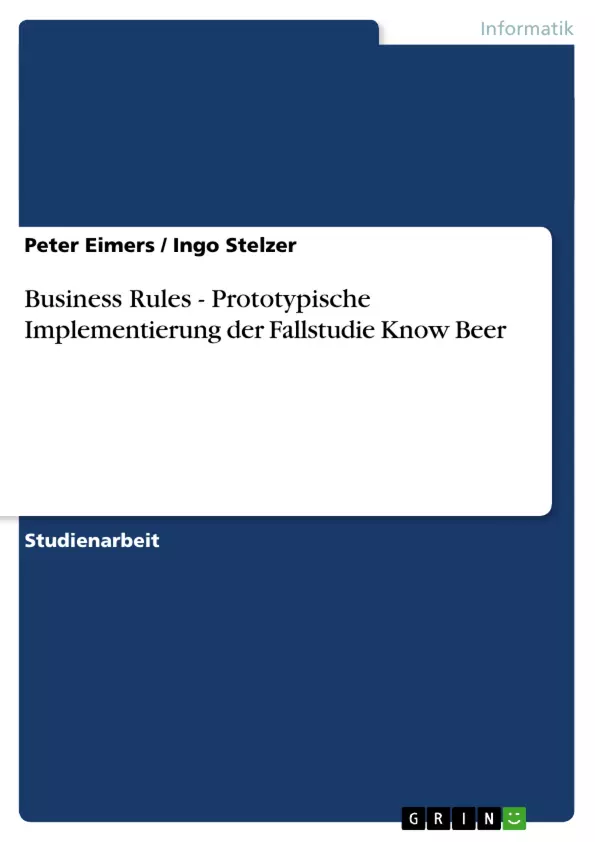The prototype implementation of the case study "Know-Beer" has shown the authors of this scientific work that complex rule case studies can be modelled with acceptable effort in context of complex business relationships.
Without a native rule modelling CASE tool like the Corticon Modeling Studio the Business Analyst and Business Owner were forced to formulate a change request to the IT development department (for e.g. Operational Development). This would trigger further processes which must be orchestrated between the different parties. This process flow needlessly binds resources and reduces the agility / productivity of the enterprise.
Corticon as a Business Rules Management System (BRMS) can therefore represent an important bottleneck factor. It can be used as leverage, consequently it has a strong distinction potential for the enterprise.
Key features
-high performance model driven processes
-closely interlocked with the daily business reality through transparent and consistent business vocabulary during the whole modelling process
-integrated web service deployment with tight database backend interaction via standardised JDBC API
-seamless ability to import XMI (XML based) vocabulary structures
Recommendation
Corticon plays its advantages best in small medium-sized enterprises (SME) because changing the vocabulary does not take much time. It is suited best for the following business branches: Insurances, telecommunications, banking sector and companies which base their decisions highly on quantitative data.
Inhaltsverzeichnis
- Management Summary
- Inhaltsverzeichnis
- Abkürzungsverzeichnis
- Problemstellung und Aufbau
- Problemstellung
- Aufbau
- Einführung
- Beschreibung des Anwendungsfalls
- Prototypische Implementierung in Corticon
- Charakterisierung des Werkzeuges
- Entwicklung des Business Vokabulars
- Regelmodellierung
- Regelung: "hat Geschäftsbeziehung seit"
- Regelung: "Kreditlimite"
- Datenbankanbindung
- Deployment und Webservice Bereitstellung
- Corticon Deployment Console
- Anwendungsintegration
- Zusammenfassung und Ausblick
- Vor / Nachteile des gewählten BRMS
- Ausblick
- Literaturverzeichnis
- Abbildungsverzeichnis
Zielsetzung und Themenschwerpunkte
Die vorliegende Arbeit beschäftigt sich mit der prototypischen Implementierung der Fallstudie "Know-Beer" im Kontext komplexer Geschäftsbeziehungen. Sie analysiert die Modellierung komplexer Regel-Szenarien mit dem Business Rules Management System (BRMS) Corticon.
- Bewertung von BRMS im Kontext von Geschäftsprozessmodellierung
- Entwicklung eines Business Vokabulars für die Fallstudie
- Implementierung von Geschäftsregeln in Corticon
- Integration von Corticon in eine Datenbank
- Deployment und Bereitstellung eines Webservices mit Corticon
Zusammenfassung der Kapitel
- Die Einführung stellt den Anwendungsfall "Know-Beer" vor und beschreibt die Ziele der Arbeit.
- Kapitel 3 konzentriert sich auf die prototypische Implementierung in Corticon, einschließlich der Charakterisierung des Tools, der Entwicklung des Business Vokabulars und der Regelmodellierung.
- Kapitel 4 behandelt die Anwendungsintegration und beleuchtet die Vor- und Nachteile des gewählten BRMS.
Schlüsselwörter
Die Arbeit konzentriert sich auf die Themengebiete Business Rules Management System (BRMS), Corticon, Geschäftsprozessmodellierung, Regelmodellierung, Datenbankanbindung und Webservice-Entwicklung. Die Fallstudie "Know-Beer" dient als Beispiel für die Anwendung dieser Konzepte in einem komplexen Geschäftsszenario.
- Arbeit zitieren
- Peter Eimers (Autor:in), Ingo Stelzer (Autor:in), 2008, Business Rules - Prototypische Implementierung der Fallstudie Know Beer, München, GRIN Verlag, https://www.grin.com/document/88633



